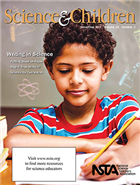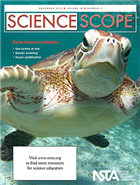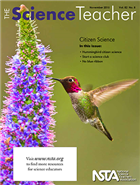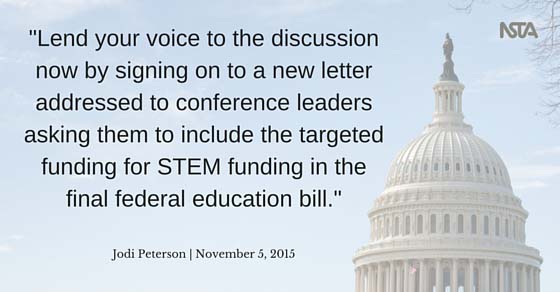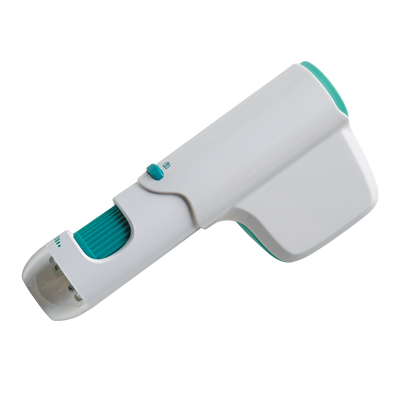Tapping into student interests
By Mary Bigelow
Posted on 2015-11-10
 It seems like it’s getting harder to get my middle school students interested in a topic. I’ve strained my brain trying to come up with new ideas. Am I the only one in this situation? —B., Arizona
It seems like it’s getting harder to get my middle school students interested in a topic. I’ve strained my brain trying to come up with new ideas. Am I the only one in this situation? —B., Arizona
You are not alone! Students have many distractions (e.g., electronics, social media), extracurricular activities, and other responsibilities competing for their time and energy. I’m sure you’ve used activities and investigations, multimedia, and a variety of instructional strategies, but it’s still a challenge.
Rather than taking on the entire responsibility of making science relevant, ask your students about their interests. This could be on the questionnaire you give them at the beginning of the year or periodically on an exit ticket in class. You can refer to the list of interests to make connections to lessons and build on student interests.
A KWL (Knows, Wants to know, and has Learned) chart can also provide insights into what students know or want to know (or wonder about). But in my experience, when asked about their interests, middle schoolers often will say “I don’t know,” try to leave the W column blank, or shrug their shoulders. Sometimes they’re afraid to try or think about something new. Sometimes it’s “cool” to act disinterested in anything academic. And sometimes students honestly don’t know much about the world beyond them.
We shouldn’t underestimate the teacher’s role in broadening student’ interests and horizons. For a professional development project, I conducted focus group interviews with high school students. One of the questions was “Did you ever think that a topic in class was going to be boring, but it turned out to be really interesting?” The students all responded positively and we followed up with the question “So what made the topic interesting to you?” All of the students said that it was something the teacher did that changed their minds: the teacher’s passion or enthusiasm for the topic, the teacher sharing a personal interest or experience, the teacher assigning interesting and challenging projects with options the students could choose from, or the teacher helping them make connections between the topic and their own experiences and interests.
Your enthusiasm can be contagious, as students enjoy hearing stories of your personal interests. When I shared some photos I had taken of coral reefs in the Caribbean, my students were intrigued—”You actually were under water?” I just happened to have some of my gear with me to show them. Several of the students had traveled with their families to the beach (our school was not in a coastal state) and shared their experiences, too. We took a vicarious dive with a brief video. At that point, most students were hooked on learning more about marine environments.
Providing options and choices is another way to engage students. Technology provides many options. As an alternative to formal reports, students could demonstrate their learning through creating videos, infographics, or presentations, working independently or as part of a team. This requires work and organization on your part, but seeing the students’ enthusiasm and creativity is worth it.
Encouraging students to take ownership in the classroom can be engaging, too. One of my colleagues started the school year with blank bulletin boards. During each unit, students added to them—vocabulary cards, reports, news and current events, drawings, photographs, maps, and so on.
Some student interests are independent of what the teacher does. Definitely encourage students to explore on their own through independent study and provide the resources to do so. One of my life science students shared her illustrated journal. She had made a list of biology terms based on Greek and Roman mythology, from the Io and Luna moths to Cyclops, Hydra, and Medusa. I learned a lot from it myself!
Keep trying. It’s hard to say what activity, strategy, or content topic will connect with a student. Think about the teachers that inspired you. What did they do?
 It seems like it’s getting harder to get my middle school students interested in a topic. I’ve strained my brain trying to come up with new ideas. Am I the only one in this situation? —B., Arizona
It seems like it’s getting harder to get my middle school students interested in a topic. I’ve strained my brain trying to come up with new ideas. Am I the only one in this situation? —B., Arizona
NSTA’s K-College November 2015 Science Education Journals Online
By Korei Martin
Posted on 2015-11-08
Looking for ways to incorporate science and writing? Want a good look at Earth systems that are normally non-accessible? Curious about how crowd-sourcing and science go together? Do you know how middle and high school level science courses affect college students’ choice of major? The November K–college journals from the National Science Teachers Association (NSTA) have the answers you need. Written by science teachers for science teachers, these peer-reviewed journals are targeted to your teaching level and are packed with lesson plans, expert advice, and ideas for using whatever time/space you have available. Browse the November issues; they are online (see below), in members’ mailboxes, and ready to inspire teachers!
A major practice of science is the communication of ideas and the results of inquiry. The articles in this issue of S&C will help you integrate science and writing in ways that strengthen both.
Featured articles (please note, only those marked “free” are available to nonmembers without a fee):
Featured articles:
- Free – Editor’s Note: Specialized Writing
- Map It Then Write It
- Poetry Rocks!
- Programming Digital Stories and How-To Animations
- Free – Putting Ideas on Paper
- Science for Two Voices
- Free – Three-Dimensional Instruction: Using a New Type of Teaching in the Science Classroom
- Full Table of Contents
No matter where you live on this planet, you won’t have to go far to find evidence of the Earth’s systems at work. In this issue, however, we provide you with a number of ways that you can explore Earth systems at work in locations that might be outside the range of your typical field trip, such as glaciers, deep-sea platforms, and active volcanoes.
Featured articles (please note, only those marked “free” are available to nonmembers without a fee):
Featured articles:
- Free – Editor’s Roundtable: Teaching for a Dynamic Planet
- Exploring the Complexity of Ocean Acidification: An Ecosystem Comparison of Coastal pH Variability
- Modeling the Physical Properties of Glaciers
- The Ocean Platform Engineering Design Challenge: Flooded With Stem Content and Practices
- There’s a Glacier in Your Backyard: Modeling Glaciers Through Active Learning
- Free – Three-Dimensional Instruction: Using a New Type of Teaching in the Science Classroom
- Troubling Tides: Will Sea Turtles Survive the Rising Seas?
- Full Table of Contents
Citizen science harnesses the power of people by crowd-sourcing data collection and analysis. In our classes, it can create opportunities for students to participate in authentic research and the generation of new scientific knowledge. The opportunities are boundless. When students participate in citizen science projects, they go beyond canned labs where the outcome is known to discover the multidimensional nature of scientific research. Students provide essential data for important investigations, as described in this issue; they analyze data sets to discover patterns and construct explanations from evidence; they ask questions, generate and test hypotheses, and become involved in meaningful research. What better way to get students excited about science?
Featured articles (please note, only those marked “free” are available to nonmembers without a fee):
Featured articles:
- 21st-Century Citizen Science
- Free – Editor’s Corner: Citizen Science
- Free – Hummingbird Citizen Science
- No Blue Ribbon
- Start a Science Club
- Free – Three-Dimensional Instruction: Using a New Type of Teaching in the Science Classroom
- Full Table of Contents
Journal of College Science Teaching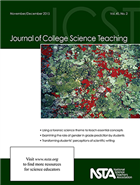
Read about a unique project designed for an introductory-level physics course that links sustainability, arts, and scie
nce in an effort to engage students in the creative process in science. See the Research and Teaching column for a study that investigated why college-level students select science majors and how the science preparation they received in middle school and high school may have influenced their choices. Meet JCST‘s new Two-Year Community column editor, Apryl Nenortas, by reading her introduction and learning about her vision for the column.
Featured articles (please note, only those marked “free” are available to nonmembers without a fee):
Featured articles:
- Research and Teaching: Implementation of Interactive Engagement Teaching Methods in a Physical Oceanography Course
- Research and Teaching: Students’ Perceptions of Factors Influencing Their Desire to Major or Not Major in Science
- The Role of Gender in Grade Perception in Chemistry Courses
- Using Project- and Theme-Based Learning to Encourage Creativity in Science
- Free – Writing Toward a Scientific Identity: Shifting From Prescriptive to Reflective Writing in Undergraduate Biology
- Full Table of Contents
Get these journals in your mailbox as well as your inbox—become an NSTA member!
The mission of NSTA is to promote excellence and innovation in science teaching and learning for all.
Follow NSTA
Ideas and info from NSTA's November K-12 journals
By Mary Bigelow
Posted on 2015-11-08
Each of the K-12 journals this month includes Three-Dimensional Instruction: Using a New Type of Teaching in the Science Classroom with suggestions on how to integrate Disciplinary Core Ideas, Science and Engineering Practices, and CroEarath ss-Cutting Concepts into our teaching. “None of the dimensions can be used in isolation; they work together so that students can build a deeper understanding as they grapple with making sense of a phenomenon or finding solutions to problems.” A must read!
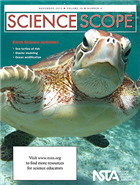 Science Scope – Earth Science Activities
Science Scope – Earth Science Activities
It’s not hard to get middle school students into the Earth Sciences, making connections with the topics and their own lives! Each featured article this month has a full-page description of how the lesson aligns with the NGSS middle school standards.
- Troubling Tides: Will Sea Turtles Survive the Rising Seas?–This 3-part activity helps students learn the concepts of critical habitat and the effects of changing sea level through modeling and data analysis.
- There’s a Glacier in Your Backyard: Modeling Glaciers Through Active Learning and Modeling the Physical Properties of Glaciers both have students make and use physical models of glaciers to explore how glaciers move, erode, and deposit materials.
- The Ocean Platform Engineering Design Challenge: Flooded With Stem Content and Practices — Students explore forces that affect objects in the oceans as they design and build a structure that can withstand these forces and draw conclusions about design constraints.
- Astrobiobound: Tying Science and Engineering Design Together — In this 5E lesson, students take on the role of scientists to decide what evidence would support the presence of life on other planets and what engineering design would be necessary to get the evidence.
- Exploring the Complexity of Ocean Acidification: An Ecosystem Comparison of Coastal pH Variability — Students analyze data to explore the variability of pH levels in coastal marine ecosystems in this 5E lesson, which includes See-Think-Wonder in the Engage step.
- Tried and True: Volcano! Investigating Plate Tectonics, Geologic Time, and the Rock Cycle — Here’s how to go beyond the baking soda/vinegar to a more in-depth understanding of the processes.
- Teacher’s Toolkit: Scaffolding Students Toward Argumentation — This article has four levels for guiding students to an understanding of argumentation.
The November issue of The Science Teacher has a Safety Acknowledgment Form for Earth Science.
Here are some SciLinks with content information and suggestions for additional activities and investigations related to this month’s featured articles: Acid Water, Astrobiology, Geologic Time, Glaciers, Hot Spots/Volcanoes, Life on Other Planets, Ocean Currents, Ocean Waves, Polar Climates, Polar Marine Ecosystems, Plate Tectonics, Properties of Ocean Water, Reptiles, Rock Cycle, Space Exploration, Volcanic Eruptions, Volcanic Features.
Continue for The Science Teacher and Science and Children.
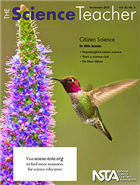 The Science Teacher — Citizen Science
The Science Teacher — Citizen Science
“Citizen science harnesses the power of people [including students] by crowdsourcing data collection and analysis.” 21st-Century Citizen Science provides a rationale for this type of global awareness and interactions, as students engage in authentic research. (Career of the Month: Citizen Scientist (and Research Chemist) describes how a chemist became a butterfly advocate.)
- Hummingbird Citizen Science — Students collect, organize, and analyze data on hummingbird feeding and other behaviors, contributing the local data to a large-scale project. There are suggestions on how this type of project can be integrated with general biology and connect to the NGSS.
- Start a Science Club — Establish a science club that engages students through partnerships with local organizations and a service-learning
component. - Sewing Up Science — Students explore electronic circuitry and create new products with e-textiles.
- No Blue Ribbon – The authors provide 5 critiques of traditional science fairs and 2 suggestions for alternatives that engage students in citizen science and engineering design.
- The Green Room: Keeping Soils Fertile — Increase students’ awareness of the science behind the “Green Revolution.”
Here are some SciLinks with content information and suggestions for additional activities and investigations related to this month’s featured articles: Characteristics of Birds, Compost, Electronic Circuits, Pollination, Science Fair, Soil Conservation, Sustainable Agriculture.
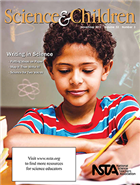 Science and Children — Writing in Science
Science and Children — Writing in Science
“Science and engineering include specialized ways of talking and writing,” and learning how to communicate the findings of investigations and the results of design projects is essential. As the article in this issue demonstrate, it’s never to early to get children thinking and communicating as scientists or engineers.
- Putting Ideas on Paper — Using the Claim-Evidence-Reasoning framework, students make predictions, explore and observe, create data charts, and write scientific explanations.
- Poetry Rocks! and Science for Two Voices — Students use poetry to process and share their observations.
- Map It Then Write It — Here are several examples of graphic organizers to help students organize their thoughts during the writing process. These are also appropriate for older students!
- Programming Digital Stories and How-To Animations and Engineering Encounters: Sailing Into the Digital Era — Students use engineering design to develop their own digital stories and e-books, including storyboards and testing/revision.
- Teaching Through Trade Books: That Was Then, This Is Now — With these two 5E lessons suggested trade books, students compare and contrast how engineering design has changed over the years, using toys and whale watching as the context.
- The Early Years: Documenting Discoveries — Students engage in long-term observations and data collection while caring for living things in the classroom.
- Formative Assessment Probes: Constructing Cl-Ev-R Explanations to Formative Assessment Probes —
- Engineering Encounters: Sailing Into the Digital Era —
- Methods and Strategies: Deep Assessment — Assessing student writing focuses on science content, inquiry, and vocabulary. The article describes these and provides a sample rubric.
Here are some SciLinks with content information and suggestions for additional activities and investigations related to this month’s featured articles: Composting, Invertebrates, Light and Color, Rocks, Sound, States of Matter, Whales, Worms.
Each of the K-12 journals this month includes Three-Dimensional Instruction: Using a New Type of Teaching in the Science Classroom with suggestions on how to integrate Disciplinary Core Ideas, Science and Engineering Practices, and CroEarath ss-Cutting Concepts into our teaching.
Let Your Voice Be Heard–Support STEM Education in Final No Child Left Behind Bill
By Jodi Peterson
Posted on 2015-11-05
Hopes mount that Congress will complete reauthorization of No Child Left Behind this fall, establishing the federal funding and programs that will help to define K-12 education for the next several years.
House and Senate education leaders and their staff are continuing their work to reconcile the differences in their respective bills (H.R. 5 and S. 1177). Lend your voice to the discussion now by signing on to a new letter addressed to conference leaders asking them to include the targeted funding for STEM funding in the final federal education bill.
We are seeking organizational (not individual) sign-on for the letter, which is below or read it here. If your organization or school/district/business can sign on to this letter, or if you have questions, please e-mail me at jpeterson@nsta.org. The letter will close on Friday, November 13. Please feel free to share this information with your networks in the state and district. Thank you.
Jodi Peterson is Assistant Executive Director of Legislative Affairs for the National Science Teachers Association (NSTA) and Chair of the STEM Education Coalition. e-mail Jodi at jpeterson@nsta.org; follow her on Twitter at @stemedadvocate.
Dear Chairman Alexander, Ranking Member Murray, Chairman Kline, and Ranking Member Scott:
As you and your staff work to reach agreement on the legislation to reauthorize the Elementary and Secondary Education Act (ESEA),we urge you to include a provision of the Every Child Achieves Act (S. 1177, Title II.E) that would provide targeted funding to each state for science, technology, engineering, and mathematics (STEM) related activities.
In recent weeks, more than 50 members of the House and Senate from both parties have also written to you in united support of making STEM education a priority within the final legislation agreement and have similarly urged the inclusion of Title II.E in the conference agreement.
This key STEM education provision would provide formula grants to the states, which then administer grants to partnerships between schools, businesses, non-profits and institutions of higher education. These state-based partners would have broad discretion under the language of the provision to decide how to best use resources to improve teaching and learning in STEM subjects. Funding would support a wide range of STEM-focused objectives including recruitment, retention, and professional development of educators. Additionally, the provision would expand learning both in and outside the classroom, support STEM-related competitions and other forms of hands-on-learning, and improve student academic achievement in the STEM areas for underserved groups.
Title II.E is not a new program. Instead, it improves upon the existing Math and Science Partnership program at the Department of Education, which has a demonstrably positive impact on nearly 2.4 million students and thousands of educators every year. The STEM funding provision is also not duplicative of STEM programs at other federal agencies. The Title II.E provision would be the only education program—at the Department of Education or any other federal agency—providing direct formula-based funding to every state for the exclusive purpose of supporting STEM-related learning.
Federal investments in STEM education are critical in helping states to prepare our students for the challenges of today’s increasingly competitive world. If we are going to empower our students to compete in the global economy we must maintain a strong federal commitment to improve teaching and learning in the critical STEM fields. It is both appropriate and essential for the nation’s most prominent education law to establish STEM education as a critical priority.
Respectfully,
National Science Teachers Association
STEM Education Coalition
The STEM in Kitchen Appliances
By Becky Stewart
Posted on 2015-11-03
We just returned from a visit to Le Cordon Bleu School in Cambridge, Massachusetts, where our older son is considering getting a culinary arts certificate after his high school graduation in (gasp!) June. We took a tour of their many kitchens, and I was impressed by the size of the mixers in the baking kitchen. Upon return, our microwave mysteriously quit working and my husband and I had a conversation about how appliances just aren’t built like they used to be. Happily, I discovered after some investigating that the unit had become unplugged from the socket in the back of the cabinet under which it is mounted. One problem solved!
All this recent exposure to the workings of kitchen appliances did make me think that there was a column in there somewhere. Modern kitchen appliances are powerful while being resource efficient, but all kitchen appliances have long histories. Many began with simple machines. The industrial-size stand mixers that they have at Le Cordon Bleu, for instance, are based on levers and wheels. (Gears are wheels with teeth.)
Power, efficiency, and energy
Early kitchen appliances were much more identifiable with their simple machine roots. My personal favorite kitchen tool is still the manual egg beater. This device, patented in 1894, was intended by its inventor to be a mixing machine for many different applications, not just eggs. The double sided drive wheel is powered by the motion of the handle and smaller gears transmit the power to the two beaters. One of the earliest kitchen appliances was the roasting jack, which was a mechanism based on the wheel for turning meat on a spit. Spits were originally turned by hand and are thought to date back thousands of years. The manual butter churn was based on a lever or a wheel. Each of these once-common kitchen fixtures has since been supplanted by a more efficient machine. When I was a child, our next-door neighbor had an old washing machine in which the agitator was powered by electricity but once the clothes were clean and rinsed the water was squeezed out by hand-cranked wringers. This method seems labor intensive by today’s standards but was a huge improvement over a tub and washboard.
The potential of electrical kitchen appliances to reduce labor was seen as early as 1917, as published in the National Electric Light Association Bulletin. At that time the author was mainly concerned with how the refrigerator would free up the ice man for military service, but other implications were becoming known as well. Labor-saving kitchen devices freed up significant amounts of time for women, allowing them the freedom to work outside the home. Early electrical kitchen appliances may have started a social revolution as early as the 1920s. Widespread adoption of electrical kitchen appliances had an undoubted influence on the women’s liberation movement.
Today’s kitchen appliances save more than just labor. Modern dishwashers are designed to be energy efficient while using significantly less water than hand washing. Most new dishwashers use less than 5 gallons of water per load. This saves energy in a couple of ways, because in addition to using less electricity to power the machine, less energy is required to heat the water.
Physics and technology
Microwave ovens make an interesting physics lesson. You may have heard the story of how microwaves were discovered by accident, when Percy Spencer, an engineer was working with the high-powered vacuum tubes that produced radio waves used in radar. He noticed that a peanut cluster candy bar in his pocket began to melt. This led Spencer to discover the existence of microwaves, which have shorter wavelengths than radio waves. Both radio waves and microwaves are forms of electromagnetic energy. These kinds of energy both have significantly longer wavelengths than the electromagnetic energy you’re most familiar with, which is light. Microwave ovens are set to emit energy at a specific wavelength, which excites water molecules in food, so that the molecules vibrate and produce heat. This heat is what cooks or reheats the food. The metal walls of the oven reflect the microwaves, ensuring that no waves escape to cause harm to hungry people.
A new technology that is making its way into kitchens is induction cooking, in which heat is generated by strong electric fields. These kinds of stovetops are safer and more efficient than their conventional ancestors. The catch to induction cooking, though, is that you can only use pans made of ferromagnetic metals on them. Other types of pan will not heat up because their electrons cannot be excited. In a lovely example of old meeting new, the precise temperature control afforded by these appliances allows even novice cooks to follow some of the recipes in Julia Child’s iconic Mastering the Art of French Cooking with something like confidence. (Words to the wise—if you attempt to use one of those recipes, read it all the way through before you begin. Maybe twice. Julia Child was precise.)
Connected kitchens
The Internet of Things is beginning to make inroads in the kitchen, as well. Options for “smart” appliances that are wi-fi enabled and controllable by an app include refrigerators, stoves. dishwashers and crockpots. (Our crockpot, in which tonight’s dinner has been cooking as I write, is not so fortunate.) I am looking forward to the day when I can put ingredients in the crockpot or oven the night before, knowing they will stay refrigerated until the appointed time, and then will be cooked to perfection by the time everyone at arrives home. All of this will be arranged with a few touches on a smartphone screen. This day may not be as far off as you think—there is already a marketed oven
that refrigerates food until it is time to cook.
Produced by the National Science Teachers Association (NSTA), science writer Becky Stewart contributes monthly to the Science and STEM Classroom e-newsletter, a forum for ideas and resources that middle and high school teachers need to support science, technology, engineering, and math curricula. If you enjoy these blog posts, follow Becky Stewart on Twitter (@ramenbecky).
Follow NSTA
Schools Offer Specialized Science
By Debra Shapiro
Posted on 2015-11-03

Students at BioTECH @ Richmond Heights High School, a conservation biology magnet school in Miami, Florida, conduct botanical research in this state-of-the-art lab. Photo: FAIRCHILD TROPICAL BOTANIC GARDEN
To motivate students to learn science, some schools are expanding the range of their courses. While at Mission Heights Preparatory High School in Casa Grande, Arizona, biology teacher Robert Gay created a paleontology program after he told his students about his training and work in paleontology, and they “felt my passion for it and were really intrigued by it,” he relates. The program, which began with one course in 2014, grew to four courses, including a two-week summer field course.
“Paleontology is a good way to engage kids in science. Kids like fossils and dinosaurs, and they want to know what is true and what isn’t: [They ask,] ‘Is Jurassic Park real?’,” he maintains, adding, “you can talk about physics, biology, and chemistry through a lens they’re already interested in.”
Paleontology is “a practical science” because “it’s the only way to know about the past…To make decisions about the future, you have to look at the past,” he observes. His students were exposed to paleoclimate data, which can help them understand climate change. “Students will understand the impacts of policy decisions,” he contends.
He also taught students how microscopic fossils help locate oil and how scars on dinosaur fossils can answer questions such as “Were their digestive systems able to process what they ate? Could a T-Rex eat you?” Students learned that many paleontologists teach at medical schools because physicians have to understand “how bones have changed,” he notes.
In his Paleontology 1 course, students learned “the history of paleontology and the history of life on Earth,” Gay explains. In Paleontology 2, they studied the techniques of paleontology, such as determining the ages of fossils. “In both courses, students [got] to apply their skills in the field,” he points out.
Students in Advanced Paleontology “do research projects that will result in publications. I want them to work on projects that can be published in a peer-reviewed journal,” Gay asserts. He has had three students write about topics including “the first appearance of a species and the abundance of species in an area.”
He continues, “I’ve seen students who have issues with reading and writing get emotionally invested in these papers. They want to understand the scientific vocabulary and produce a good and professional paper. Their literacy skills are on the rise.”
The application process to attend the summer field school was very competitive. “We take five to six students to south Utah for two weeks. It’s a really intensive camp,” he notes. Students had to pass the other three courses and submit a letter of interest and letters of recommendation. “It’s preferred that they have taken Earth science and biology as well,” he adds. “We’ve collected more than 300 specimens,” he reports. “My students made amazing finds this summer,” such as a dinosaur tooth from the Triassic period.
Safety, Transportation
One challenge Gay faced with the field portion of these courses was “most of the students have never even been camping before. They ask, ‘How will I go to the bathroom? How will I groom myself ?’” He answers all of their questions and covers field safety in the Paleontology 1 course. In addition, “we have briefings at the beginning of each field session on dehydration and [the need for] sunscreen use…Students are trained not to panic if trapped by a flash flood,” for example, he reports.
Gay and adult volunteers were certified in first aid and CPR; every vehicle had a first-aid kit. Adults kept students in visual range and carried cell phones.
Back in the lab, students wore safety goggles and ear protection when using the air scribe, which Gay describes as “a mini jackhammer that removes rock from fossils.” To protect against dust, “we have a fan and open-air ventilation,” he notes. “Our chemical use is very limited [because] we don’t have a fume hood, so students work with vinegar in a separate room.”
Gay’s other major challenge—and expense—was transportation to field sites because school buses were too large. “We had a pickup truck donated, but we need[ed] a new vehicle. When we go to Utah, it’s 600 miles one way, and we [would] have to rent SUVs and minivans.” Though Gay obtained grant funding for his courses, students had to pay for transportation expenses. He would offer financial aid to students who couldn’t afford the fees.
The paleontology program was “a lot of work, but very much worth it,” Gay concludes. Since most of Mission Heights’ students come from low-income families for whom travel is a luxury, “they get to see sights and do things they normally couldn’t do. Their parents really like that,” he observes. “My students are doing well and getting noticed by colleges. [The program gave] them the chance to do something that improves their future—even if they don’t go into science.”
Next Generation Botanists
In Florida, the Fairchild Tropical Botanic Garden of Coral Gables worked with Zoo Miami and Miami-Dade County Public Schools to establish BioTECH @ Richmond Heights High School, a conservation biology magnet school that offers the first botanical field research program in the nation, along with a zoology program. “There’s a growing need for people with a background in botany [because] the botany community worldwide is aging out,” says Amy Padolf, Fairchild’s director of education. “It’s harder to find botany instructors because in Miami schools, not enough students are interested in botany. [The botany program was established because] if kids get the interest early, they’ll want to study it.”
“We’ve brought in kids who were initially attracted to the zoo, but many of them decide to go into botany because they’ve developed an appreciation for plants,” observes Daniel Mateo, BioTECH’s assistant principal. “With plants, so many genetic modifications are possible…Plants aren’t boring.”
BioTECH’s students “learn about the interconnectedness of all living things, [including] how the animals, like the mega fauna at the zoo, need plants to survive,” says Padolf. “[Students learn that] the seawater level in Miami is rising, and we need mangrove trees to stop that.”
With a student body that is 76% “of Latino descent” and 22% “African American/Caribbean,” BioTECH represents “the new face of science education” and aims to produce “the next generation of botanists,” she asserts.
BioTECH students engage in “actual, practical, authentic research projects” in the school’s state-of-the-art labs and greenhouse and work with scientists in the field at Fairchild and the zoo, says Mateo. “There is project- based learning in every course, and conservation biology is incorporated into every subject…We have 14-yearolds manipulating variables and doing what researchers do.”
When BioTECH opened in 2014, students began micropropagating native orchids as part of the Million Orchid Project, which Fairchild created with the goal of reintroducing 1 million endangered orchids to Miami’s public spaces. “Our students are propagating f
rom seed, which is difficult to do,” Mateo points out. Students presented their findings and growing methods to visitors at the International Orchid Festival in March 2015.
As juniors and seniors, students will take the college-level Introduction to Botany course and focus their research on a particular topic, according to Padolf. Fairchild “will work with them to get their research published in peer-reviewed journals,” she notes.
This article originally appeared in the November 2015 issue of NSTA Reports, the member newspaper of the National Science Teachers Association. Each month, NSTA members receive NSTA Reports featuring news on science education, the association, and more. Not a member? Learn how NSTA can help you become the best science teacher you can be.
The mission of NSTA is to promote excellence and innovation in science teaching and learning for all.
Follow NSTA
WiFi Microscope
By Edwin P. Christmann
Posted on 2015-11-02
The WiFi Microscope facilitates STEM education (Science, Technology, Engineering, Mathematics) by enabling small or large groups of students to participate microscope investigations by sharing images and videos on their connected smartphones and tablets. The WiFi Microscope can be used with both iOS and Android operating systems. The WiFi Microscope features adjustable LED lights, a camera for capturing still images and videos, and a 80X magnification zoom option. The device requires three AA batteries, which are included. Each WiFi microscope can connect with three users that are within ten meters of the device, which should provide coverage to all students in a typical classroom.
Before images can be shared remotely on tablets or smartphones, the Wi-Viewer app needs to be installed on each device. The app is available through the iOS app store and Android’s Google Play app store.
https://itunes.apple.com/us/app/wi-viewer/id588252158?mt=8
https://play.google.com/store/apps/details?id=com.elansat.wiviewer
You’ll also need to sync the WiFi Microscope to each device by following the simple instructions provided. Once the Wi-Viewer is connected, the image seen by the microscope can be shared with each smart device connected. Still images and videos can be captured using a button on the front of the WiFi Microscope. Lighting and magnification can also be adjusted using controls on the camera. Here is a video of the microscope being used:
[youtube]https://youtu.be/HUFwU7ggtvk[/youtube]
The WiFi Microscope offers many opportunities for students to engage in online, collaborative microscope investigations. I found the device to be a user friendly tool that engages students in technology-based inquiry by linking a piece of lab equipment with devices that have become part of their everyday lives.
Estimated Cost:
$787.80
Specifications:
http://www.califone.com/pdf/spec_sheets/CM2W_Spec.pdf
Edwin P. Christmann is a professor and chairman of the secondary education department and graduate coordinator of the mathematics and science teaching program at Slippery Rock University in Slippery Rock, Pennsylvania, Karlie Comfort is a graduate student and a research assistant in the mathematics and science teaching program at Slippery Rock University in Slippery Rock, Pennsylvania, and Mary Karavias is a graduate student and a research assistant in the secondary education program at Slippery Rock University in Slippery Rock, Pennsylvania.
Legislative Update
Will STEM Education Be the Child Left Behind?
By Jodi Peterson
Posted on 2015-11-01
Last week in the Senate, Senators Franken and Kirk circulated a Dear Colleague letter addressed to the ESEA conference leaders, asking them to include the Senate language they introduced (and was passed) in the Senate bill that includes targeted funding for STEM education. As of Friday, October 30, 2015, the letter was signed by 16 Senators, (Kirk, Ayotte, Gillibrand, Cantwell, Coons, Mikulski, Stabenow, Heinrich, Murphy, Wyden, Hirono, Baldwin, Merkley, Capito, Blumenthal, and Udall). NSTA and the STEM Education Coalition were very active in garnering support for this Dear Colleague. As you will recall from previous legislative updates, a similar House Dear Colleague letter supporting the Senate language with dedicated STEM funding in the final ESEA conference bill sponsored by Representatives Hanna and Courtney garnered 34 signatures from both sides of the aisle.
“Will STEM education be the child left behind?” was the question asked during an October 28 NPR report. NPR report Eric Westervelt explored the differences for science education funding in the House and Senate NCLB reauthorization bills now under consideration (the Senate bill maintains language for a STEM end program, the House bill does not), noting that as legislators work toward passage of a final ESEA bill, “with hard-line House Republicans in full revolt, it’s possible the Senate’s STEM provisions would disappear in the inevitable legislative horse-trading.”
Although conferees for the final bill have not been named yet, Congressional education leaders and their staff are working behind the scenes on working out differences between the two bills. Stay tuned.
Also in the Past Week
As widely reported by most media outlets, Congress and the White House came to terms on a two-year budget deal that would lift the sequestration budget caps and address a range of short- and long-term spending issues. The deal would raise the FY2016 budget caps by $25 billion each for defense and non-defense spending (including education) and by $15 billion each in FY2017. It will allow lawmakers to complete the remaining appropriations bills before the December 11th Continuing Resolution expires. Also important is the fact that this deal could help Rep. Paul Ryan, the new speaker of the House (and responsible for setting the House legislative agenda), push through with the final reauthorization of the ESEA. Read more.
ED Wants to Reduce Testing
Following a report from the Council of the Great City Schools on student testing in urban schools, the U.S. Department of Education and President Obama announced the Department would “review its policies to address any places where the Administration may have contributed to the problem of overemphasis,” and released a Testing Action Plan that “presents principles for fewer and smarter assessments, specific steps the department is taking to mitigate the issue, and examples of state and local efforts to reduce testing.” The Department recommends that “states place a cap on the percentage of instructional time students spend taking required statewide standardized assessments to ensure that no child spends more than 2 percent of her classroom time taking these tests.”
NAEP Math and Reading Scores Released
Finally, politicians and Department of Education officials took keen note of the NAEP scores released this week, which were sobering: Fourth-graders and eighth-graders lost ground on national mathematics tests this year. Eighth-grade reading scores dropped, and fourth-grade reading performance was stagnant. Large achievement gaps between the nation’s white and minority students and between poor and affluent children still exist in both subjects.
Jodi Peterson is Assistant Executive Director of Legislative Affairs for the National Science Teachers Association (NSTA) and Chair of the STEM Education Coalition. e-mail Jodi at jpeterson@nsta.org; follow her on Twitter at @stemedadvocate.
The mission of NSTA is to promote excellence and innovation in science teaching and learning for all.
Follow NSTA
Games for vocabulary
By Mary Bigelow
Posted on 2015-10-29
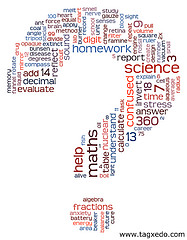 I like to provide activities that help students learn science vocabulary, but at a recent department meeting we discussed the value (if any) of word games and puzzles. Do you have any insights or research on the topic? –W., New York
I like to provide activities that help students learn science vocabulary, but at a recent department meeting we discussed the value (if any) of word games and puzzles. Do you have any insights or research on the topic? –W., New York
Many K-12 teachers use word games and puzzles to help students review concepts and learn vocabulary. The puzzles are available to students who finish other activities early or in emergency packets for substitute teachers. As long as they are not overused, many students seem to enjoy puzzles as well as word games that include active use of the words.
Find-a-words or jumble puzzles focus on word recognition, and I’m not convinced they are effective learning tools worth the time to find, create, or solve (or assign as homework, as I once saw a teacher do). On the other hand, crossword puzzles and similar games ask students to think of words to fit the clues (or clues to fit the words), which reinforces a knowledge of definitions and context, spelling, and differentiating between similar terms.
Teachers spend many hours creating or finding puzzles, duplicating them, and using class time for students to complete them. How do we know if solving these puzzles is an effective learning strategy?
I found a study, Reviewing for Exams: Do Crossword Puzzles Help in the Success of Student Learning?, that looked at the value of this type of review. The introduction describes different types of puzzles and a rationale for using each. The results of the study were mixed, but the conclusions are fodder for discussion. For example, do students understand that games and puzzles can help them learn, as opposed to being strictly a recreational or “fun” activity? (I sometimes used a crossword puzzle as an alternative to a traditional quiz. The students were incredulous at first: “This is fun—it can’t be a quiz!”)
In NSTA’s Journal of College Science Teaching (JCST), the authors of Utility of Self-Made Crossword Puzzles as an Active Learning Method to Study Biochemistry in Undergraduate Education put a different spin on puzzles. Rather than asking students to complete teacher-made puzzles, the students were asked to create crosswords using key concepts from the course. (The article has the instructions for the puzzle-makers and an example.) A majority of the students felt that the puzzles enhanced their learning of biochemical concepts and their exam scores were slightly higher (although no level of significance was included).
Designing and Solving Crossword Puzzles: Examining Efficacy in a Classroom Exercise describes a case study with suggestions and comments from students, including the survey questions that were used. The article also has a discussion of the value of word games in the classroom.
These studies were conducted with college-level students. It would be interesting to repeat with younger students, and I thought of some questions that would make interesting action research at the K-12 level (and a professional development opportunity): What would happen if other students were given peer-created puzzles to solve—would this additional level of review be helpful? Would this provide feedback on the clarity of the clues or help designers target the areas they need to study more? What would the design process look like as a team project?
From the example given in the JCST study, it appears that the puzzles were created manually with students manipulating the words, creating the puzzle grid, and submitting a version in which they filled in the answers. Would there be a difference if the students were to use an online puzzle generator or app in which most of the design work was done by the program? Hmmm…
Tailoring professional development to the needs of a small group
By Peggy Ashbrook
Posted on 2015-10-26
I sometimes wish I could have another hour or more with a presenter of a session at a  conference or other professional development program. I want to more-fully explore the ideas presented or a question the discussion raised in my mind. I was able to try to fill this niche for two teachers in an early childhood full-day program for children ages 2-5. They wanted to expand their understanding of physical science and their strategies for teaching it.
conference or other professional development program. I want to more-fully explore the ideas presented or a question the discussion raised in my mind. I was able to try to fill this niche for two teachers in an early childhood full-day program for children ages 2-5. They wanted to expand their understanding of physical science and their strategies for teaching it.
We had joint meetings and discussions, participated in hands-on explorations, viewed video of ourselves and did independent reading. I led modeling of lessons. The objective and outline follows and I hope you will comment on it, and also describe professional development that was most beneficial to you, or training that you presented that you think helped early childhood educators understand more about science inquiry and the practices of science and engineering, and teaching them.
An example of a 7-week series about physical science for a small group of educators
Training Objectives:
Through examining their own practice, and the science education standards and position statements based on research into how children learn, participants will expand their knowledge of:
- the nature of science,
- selected science content,
- resources for early childhood science education, and
- how to implement science inquiry in the context of the program’s emergent curriculum.
We will begin with the understanding that we are learners together, seeking to understand how children learn and how to teach science and engineering concepts in early childhood programs. Hands-on exploration of materials by the participants will reveal ways to engage children and scaffold their understanding of science concepts.
Participants will examine the 2014 National Science Teachers Association’s position statement on Early Childhood Science Education and the standards used by their own early childhood center. Discussion will center on:
- the practices of science and engineering as described in A Framework for K-12 Education,
- how “science inquiry” is part of the practices, and
- what the practices look like in the emergent curriculum of an early childhood classroom.
Through their experience doing hands-on manipulation of materials to make changes, observing model teaching, and through discussion, participants will understand the value of using open-ended productive questions to focus children’s attention on problem solving rather than solely teaching children science facts.
Participants will develop a beginning understanding of physical science concepts or expand upon their current level.
Participants will be able to implement physical science inquiries in their classrooms.
Discussion topics: Independent reading:
|
Meet and tour classrooms. Read the NSTA EC Science Education position statement, discuss, and develop questions to follow up. View the EC science inquiry chart in Worms Shadows and Whirlpools and look for connections with the NSTA position statement. Discuss our goals and interests. Reviewing the resource list. |
Read selections from Worms Shadows and Whirlpools by Karen Worth and Sharon Grollman. List and briefly describe 3 successful science or engineering moments, lessons or explorations that have taken place in your classroom. |
|
Introduction to: What is engineering? Discussion: Facilitating children’s problem solving. Favorite science tools. View video clips from CEESTEM (http://www.uni.edu/rampsandpathways/) and discuss how to implement in our own programs. Sharing our lists of successes. |
Read: Elsteegst, Jos. 1985. The right question at the right time. Rowe, Mary Budd. 1986. Wait Time: Slowing Down May Be A Way of Speeding Up! |
|
Participants will explore ramp materials without children present. View and discuss video of teacher-led reflection on child’s ramp exploration. What are appropriate science and engineering topics for early childhood inquiry? How does the setting change what is appropriate? How is “appropriate” related to “effective”? |
View video clips and read materials from Peep and the Big Wide World-Ramps and the Regents Center Ramps and Pathways websites. Read: Science 101 columns in Science and Children: Why Don’t All Rolling Objects Reach the Bottom of an Incline at the Same Time? and Q-Do Moving Objects “Carry” a Force With Them? Read: “Newton’s First Law: Not So Simple After All” by William C. Robertson, Jeremiah Gallagher, and William Miller in Science and Children. |
|
Teachers, try out demonstrations described in readings without children present. Peggy will model introducing ramps to classes of preschool children, or introduce a ramp challenge to a small group that has already been using ramps. |
Read selections from Worms Shadows and Whirlpools. Read “Let it Roll! Exploring motion with young children” by Kathy Cabe Trundle and Mandy McCormick Smith in Science and Children. Read The Early Years columns: October 2005 and January 2008. |
|
What can children learn about magnetic force? Teachers use materials without children present and discover some answers to this question. Discuss what vocabulary and concepts are developmentally appropriate. |
Read: The Early Years columns: January 2007, March 2007, March 2009, December 2009, October 2012. |
|
Properties of light explorations for young children. Review of a variety of activities to explore light and shadows, and hands-on explore materials for 2 of them. |
Prepare to video yourself teaching a science concept—10 minutes of video, in any part of the day and any structure. |
|
View our video and discuss what we will do next in the science or engineering investigations are going on in our classes. |
Signing up for the NSTA Learning Center and reading a forum thread. |
|
Share your practice and new knowledge and resources with other educators. |
What would you add or omit from this professional development?
I sometimes wish I could have another hour or more with a presenter of a session at a  conference or other professional development program. I want to more-fully explore the ideas presented or a question the discussion raised in my mind. I was able to try to fill this niche for two teachers in an early childhood full-day program for children ages 2-5.
conference or other professional development program. I want to more-fully explore the ideas presented or a question the discussion raised in my mind. I was able to try to fill this niche for two teachers in an early childhood full-day program for children ages 2-5.




